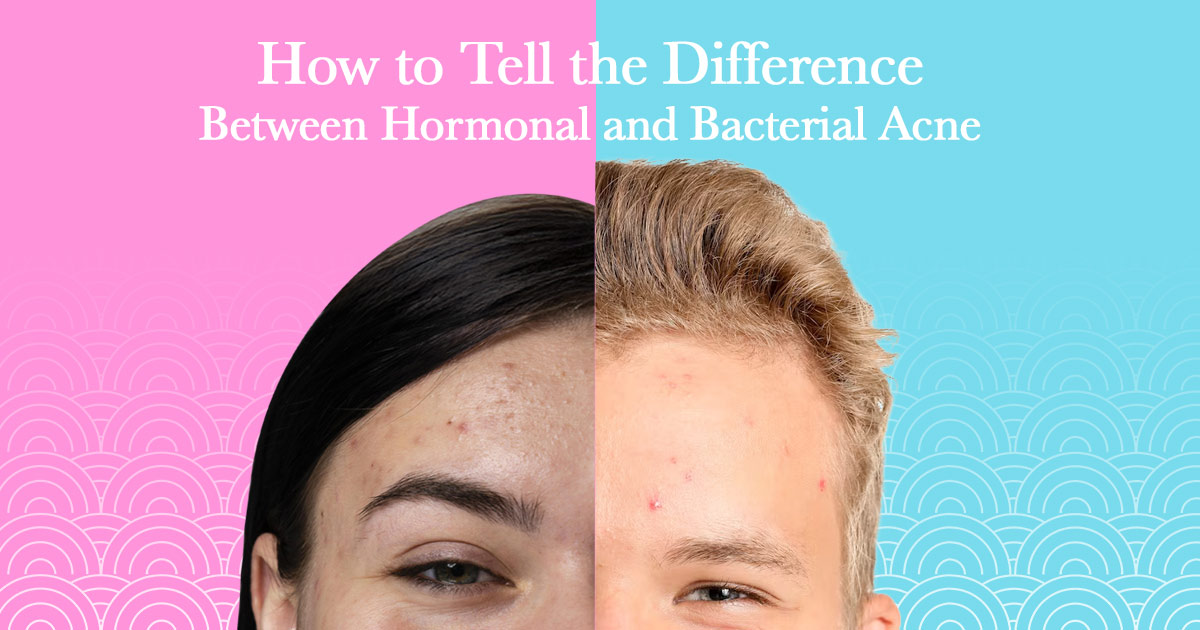How to Tell the Difference Between Hormonal and Bacterial Acne

Acne is one of the most common skin issues. Honestly, almost everyone deals with it at some point. Fun fact (or not-so-fun, really): around 50 million people in the U.S. get acne every year. But if you’re struggling to clear your skin and nothing seems to be working, there’s a good chance you’re not treating the right type of acne.
The two big “categories” are hormonal and bacterial acne, and they’re very different. Knowing which one you have? That’s key to getting the right treatment.
What’s Up with Hormonal Acne?
Hormonal acne does exactly what it sounds like—it’s caused by those annoying hormonal changes we all love to hate. Think puberty, your menstrual cycle, pregnancy… even stress can throw those hormones out of whack. And when that happens, your skin produces more oil, which clogs your pores and, boom, breakouts.
Signs Your Acne is Hormonal
- Where it shows up: It usually targets the lower part of your face, like your jawline, chin, and sometimes your cheeks.
- When it flares up: Ever notice those extra bumps right before your period? Or during ovulation? That timing’s a dead giveaway for hormonal acne.
- What it looks like: Deep, painful bumps (the ones that sit under your skin and never seem to heal). These aren’t your average whiteheads.
- Bonus clues: You might also notice irregular periods, hair where you don’t want it (looking at you, chin hairs), or even thinning hair.
How to Deal with Hormonal Acne
- Prescription help: Birth control pills or spironolactone (a medication that tones down those oil-producing hormones) can do wonders.
- Skincare to the rescue: Ingredients like retinoids or benzoyl peroxide can help prevent clogged pores and calm the inflammation.
- Simple lifestyle fixes: Cutting back on sugar, getting enough sleep, and finding ways to de-stress (hello, Netflix binge) can make a difference.
What Is Bacterial Acne?
Now, bacterial acne is a whole other story. This type is caused by bacteria hanging out in your pores, having a party (no, they didn’t RSVP). It’s often triggered by things like not washing your face after sweating, wearing heavy makeup, or just having oily skin.
How to Spot Bacterial Acne
- Where it appears: It loves the T-zone (forehead, nose, and chin), where your skin tends to be oiliest.
- How it looks: Bumps everywhere. We’re talking whiteheads, blackheads, pimples, and those red, pus-filled pustules that tempt you to pop them (don’t).
- When it pops up: This can happen any time, and it usually flares when you slack on your skincare routine or get stressed.
How to Tackle Bacterial Acne
- Go-to ingredients: Reach for products with benzoyl peroxide (it kills bacteria) and salicylic acid (great for unclogging pores).
- Antibiotics: If it gets serious, your dermatologist might prescribe oral antibiotics like doxycycline to tackle the bacteria from the inside.
- Hygiene rules: Wash your face, don’t sleep in makeup, and keep things like your phone screen and pillowcases clean. Little habits like those can make a big difference.
How to Tell the Difference Between Hormonal and Bacterial Acne
Still not sure what you’re dealing with? Here’s a quick cheat sheet to help you figure it out:
| Things to Check | Hormonal Acne | Bacterial Acne |
| Where it shows up | Jawline, chin, lower cheeks | Forehead, nose, chin (T-zone) |
| When it flares up | Like clockwork before your period | Anytime, often with poor skincare habits |
| What it looks like | Deep, under-the-skin cysts | Whiteheads, blackheads, pustules |
| Other signs | Period issues, extra hair, or hair thinning | Usually just the acne itself |
If this still feels confusing, don’t worry! A dermatologist can help you figure out what type of acne you have with tests like hormone checks or even pore swabs.
Effective Tips to Keep Acne in Check
Regardless of your acne type, these tips can help:
- Set a skincare routine: Cleanse, moisturize, and always use sunscreen. Simple, but effective.
- Quit picking: We’ve all been tempted to pop that pimple, but it’s never worth the scars or spreading bacteria.
- Go non-comedogenic: Whether it’s makeup or skincare, look for products that won’t clog your pores.
- Chill out (literally): Stress makes everything worse, so find ways to relax.
If you’re stuck in acne limbo, my advice is simple: Pay attention to the patterns and don’t be afraid to reach out to a dermatologist. Acne doesn’t define you, but figuring out how to treat it can leave you feeling way more confident. And trust me, clear skin is totally worth the effort.
